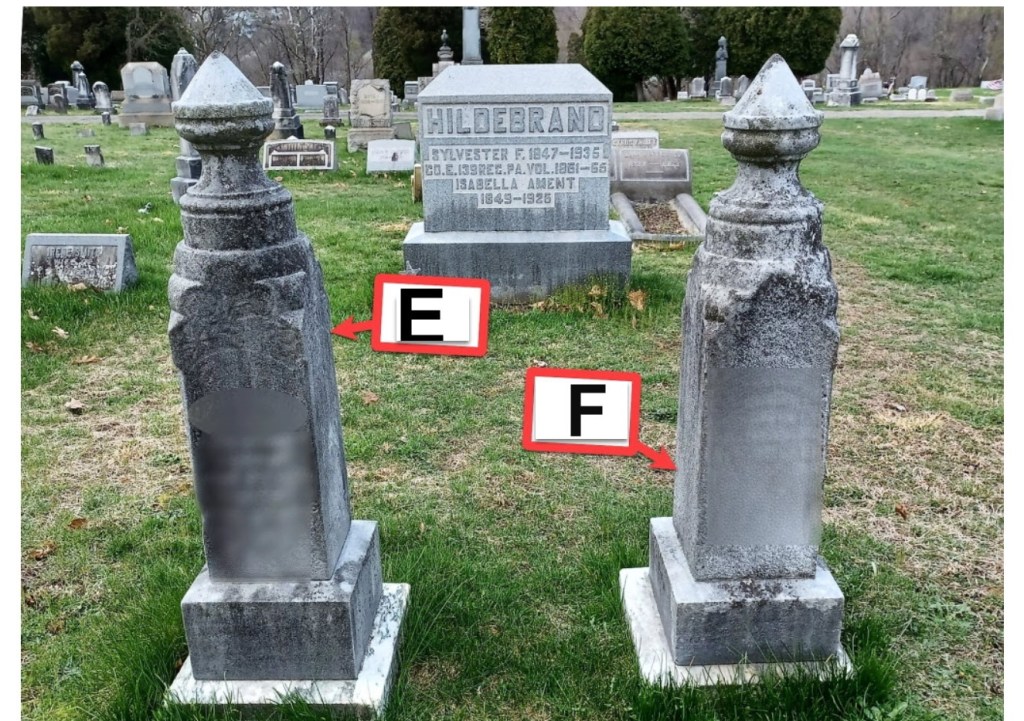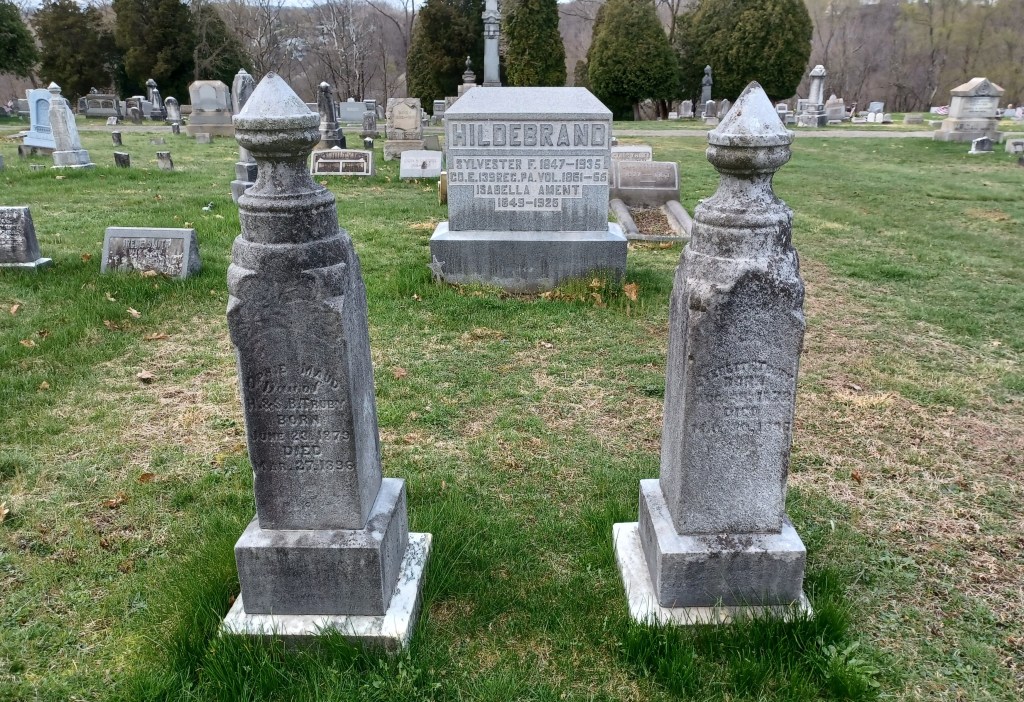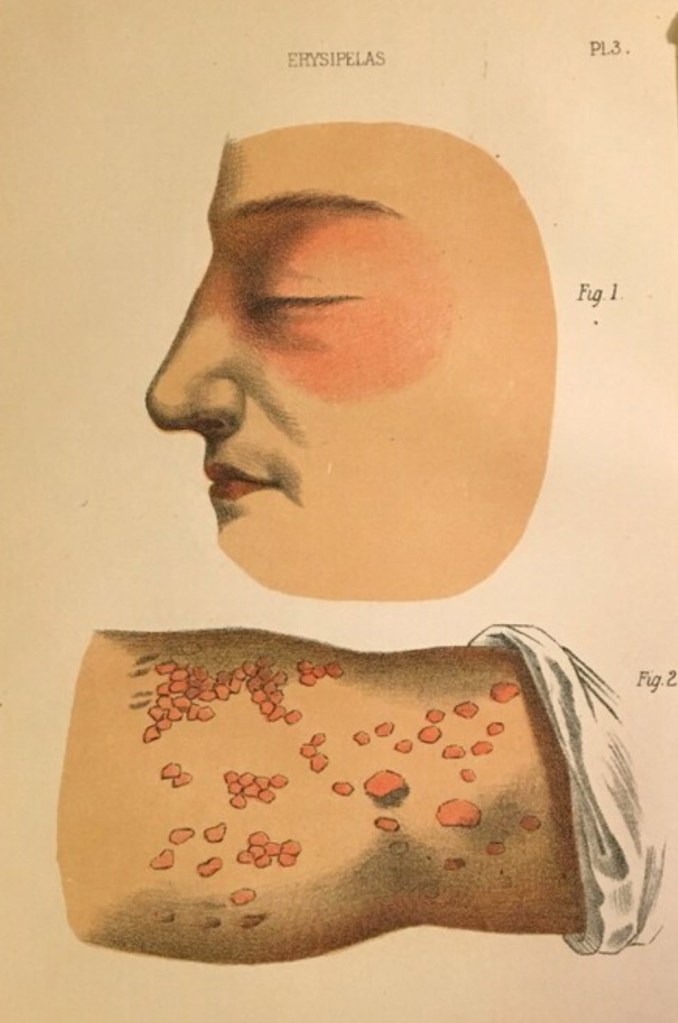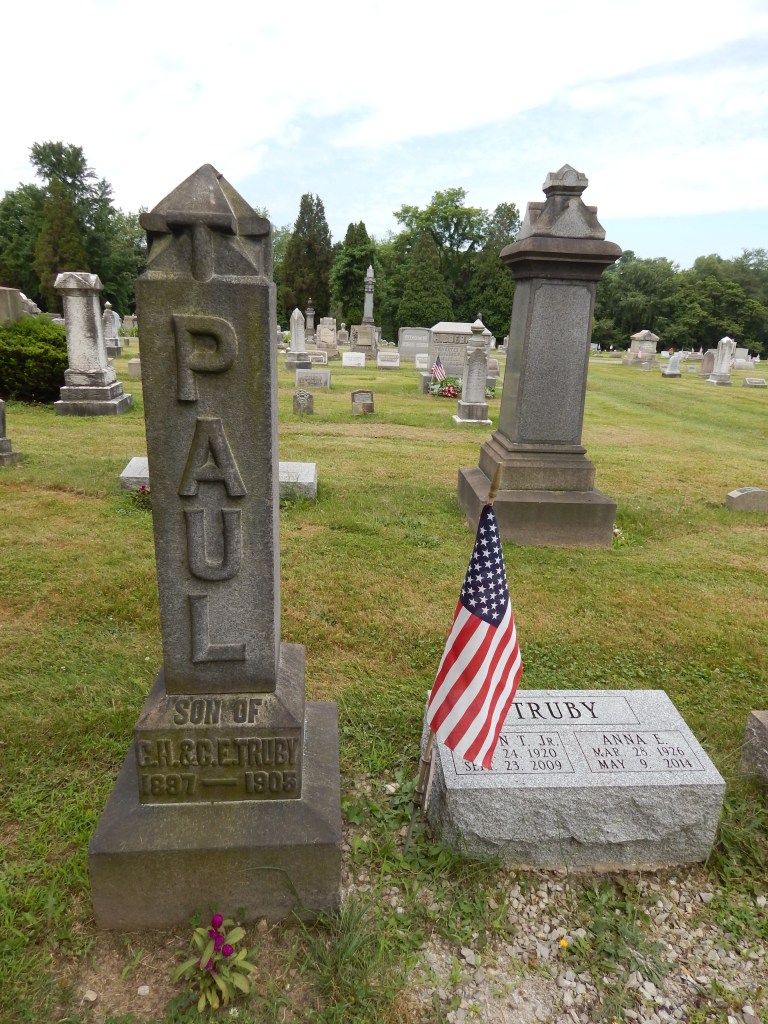In the old section of Apollo’s Riverview Cemetery lies the gravestone of Apollo farmer Simon Truby (1806-1886) and his wife Elizabeth Hill Truby (1826-1901). Their stately and imposing tombstone, shown above, is over 6 feet tall, as seems befitting of the prominent landowner, who passed from this Earth at the age of 79. Look around at nearby graves, and you’ll see markers for more Trubys and other local families, like the Jacks and the Hildebrands.
But it’s the nearby graves of two of Simon’s grandchildren that usually capture my attention and pull at my heartstrings.
Ophelia and Everett Truby were the oldest children of Simon Truby’s eldest son, Henry Hill Truby, and Henry’s wife, Sarah Belle Whitlinger Truby. Ophelia and Everett both died in 1896, just two months apart. Their deaths likely occurred a few years after the photo below was taken. In the photo of Henry Hill Truby’s family, Ophelia and Everett both look serious and somewhat sad, at least to my eyes. OTOH, the entire Truby family looks pretty somber. That seems to be the style of many photos from the late 1800s.

The siblings’ gravestones raised so many questions in my mind: How and why did they die so young? Were their deaths somehow related? Or did fate just deal that family a terrible blow that year? As I looked around, other nearby graves seemed even more puzzling. Some tombstones, it seems, almost beg us to uncover their stories.
It’s true that tombstones can be a source of family facts and dates, and they can hint at a family’s prominence within a community. But they can also generate mysteries and pique our curiosity. You can reach some conclusions about a person or family based on grave markers alone. But a little research will likely uncover new facts, and new data that may differ from our initial expectations. For some grave markers, the person’s real story may never be uncovered.
To demonstrate, how would you like to try a little armchair gravestone speculation? See if you can match the grave markers below to the brief bios of a few Truby family members. Of course I don’t want to turn gravestones into a guessing game. Rather, please think about the types of assumptions we might make when encountering grave markers. And consider how initial guesses can match or differ from the facts.
The six graves below are marked with letters A to F, and grave text is blurred out. Scroll down to see brief bios of six Simon Truby descendants, and click on quiz links to guess who might be in what grave, based on what you see.




 Henry Hill Truby, eldest son of Simon and Elizabeth Truby. He inherited the Truby farmhouse after his parents’ death and continued to manage the shrinking farm for several years. He had 8 children and died at age 77, in March 1927.
Henry Hill Truby, eldest son of Simon and Elizabeth Truby. He inherited the Truby farmhouse after his parents’ death and continued to manage the shrinking farm for several years. He had 8 children and died at age 77, in March 1927.
 Sarah Belle Truby, wife of Henry Hill Truby, had 6 children and two stepchildren. She died of a stroke at age 64, in April 1914. After Sarah Belle’s death, her widowed husband continued to live in the farmhouse on Terrace Ave with their adult son Clark and his family.
Sarah Belle Truby, wife of Henry Hill Truby, had 6 children and two stepchildren. She died of a stroke at age 64, in April 1914. After Sarah Belle’s death, her widowed husband continued to live in the farmhouse on Terrace Ave with their adult son Clark and his family.
 Ophelia M Truby, the eldest daughter of Henry and Sarah Belle Truby. She died at age 16, in March 1896.
Ophelia M Truby, the eldest daughter of Henry and Sarah Belle Truby. She died at age 16, in March 1896.
 Everett Truby, the eldest son of Henry and Sarah Belle. Everett died two months after his sister Ophelia, in May 1896.
Everett Truby, the eldest son of Henry and Sarah Belle. Everett died two months after his sister Ophelia, in May 1896.
Paul Truby, the youngest son Charles H Truby, who was farmer Simon Truby’s youngest son. Paul died at the age of 8 of unknown causes.
Belle Truby Carpenter, Henry Hill Truby’s sister, who lived around the corner from the Truby farmhouse. Her husband Samuel C Carpenter fought in the Civil War. Belle died at age 74, in May 1927, just two months after the death of her brother Henry Hill Truby.
How did you do with the quiz, and what are your thoughts about the gravestones? Did you find anything unexpected? If yes, can you come up with possible explanations? Please share comments at the end of this blog post, if you’d like.
To me, the most surprising and sad was the tiny gravestone of Simon Truby’s eldest son, Henry Hill Truby. And the most puzzling (and also sad) were the matching markers for Henry’s eldest children, Ophelia and Everett Truby.
Please read on for more info about the six graves and people, in chronological order based on their dates of death.

Ophelia and Everett Truby died in 1896 (Graves E & F). I’d been looking for information on Ophelia and Everett for years—since first encountering their graves in 2014—with little success. Their prominent tombstones are nearly 5 feet tall. The marker on the left reveals that Ophelia died in 1896 at age 16, about a month shy of her 17th birthday. Everett died just two months later, at age 23. But information on these siblings had been hard to come by.

Records from the Apollo United Methodist Church show that Everett Forest Truby was baptized on March 9, 1873, when he was about 7 months old. And Ophelia was baptized at age 11, along with her 5 younger siblings, in July 1890.
Ophelia and Everett also appear in the 1880 census, when they’re living with their parents in Apollo. Everett is 7 years old, and Ophie 11 months.
But I could find no more documentation about their lives or cause of death. Most data from the 1890 census are unavailable, as they were destroyed by a fire in 1921. So I couldn’t learn of their status when Everett was 17 and Ophelia 11 years old.
I wondered if a contagious illness might have struck them both. But Pennsylvania death certificates are spotty or non-existent before 1905. I looked but couldn’t find evidence in old local newspapers of contagious illnesses sweeping through the region; they died a couple decades before the 1918 flu pandemic.
I tried searching their names in multiple newspapers and other sources, to no avail….until a couple of weeks ago, when I finally uncovered a brief mention of Everett’s death in the Saltsburg Press. Ophelia had died two months earlier, but the cause of her death still remains a mystery.

According to the article, Everett Truby had a job working for the Pennsylvania Railroad, and he died from a bacterial infection of the skin called erysipelas, which can be deadly even today if left untreated. Erysipelas can arise when Streptococcus or other bacteria get into the body through a break in the skin, such as via a cut, scrape, burn, or animal bite. It was sometimes called St Anthony’s fire because of the searing pain and intense red rash it can cause.

A popular medical book from 1885 shows typical rashes caused by erysipelas. The book notes: “The face is the most frequent seat of the disease. It commonly begins on one side of the nose, and soon spreads over one side of the face, closing up the eye, and changing the features in a shocking manner. See Plate III, Fig. 1.”
Other symptoms of erysipelas can include chills, pain in the back and limbs, low spirits, nausea, fever, and sometimes “low, muttering delirium.”
Click here to read the full description of erysipelas in the medical book. It might not be appropriate reading for some genteel readers. There’s also a brief blurb about erysipelas treatment that appeared in the Leechburg Advance less than a month after Everett’s death.
In 1885, recommended treatments for erysipelas included rest and mild diet to reduce fever, and nitrate of silver or a dusting of flour applied to the skin to reduce inflammation. One doctor reported success treating patients with 4 to 6 ounces of port wine daily.
Today erysipelas is usually cured by antibiotics that kill the bacteria. But that option wasn’t available to Everett Truby. Penicillin wasn’t discovered until the 1920s and didn’t come into widespread use until the 1940s. So the bacteria likely got into his bloodstream and spread throughout his body, ultimately leading to his death.
We can’t know for sure if 23-year-old Everett was still living with his parents in the Truby farmhouse when he became ill. The Saltsburg Gazette only notes that he “died at his home in Apollo.” But the family of Henry and Sarah Bell Truby was surely reeling, having just lost their two oldest children. It must have been terribly hard on the younger siblings.
In 1896, the year of Olivia and Everett’s deaths, their parents may have been at the height of their wealth. Family patriarch Simon Truby had died a decade earlier, in 1886. And his estate was fully settled by 1893, when most of his farmland had been sold. (The executors of Simon’s estate were his wife Elizabeth and Simon’s eldest son, Henry Hill Truby). Each of Simon’s eight children or their heirs had inherited about $3,300, or more than $111,000 in today’s money.
It makes sense that the unexpected deaths of two children could lead newly wealthy parents to memorialize their loved ones with the most prominent markers they could afford. And it appears that Henry and Sarah Belle Truby did just that. Ophelia and Everett are buried very close to the conspicuous graves of their grandparents Simon and Elizabeth Truby.
And it seems this type of motivation may lie behind the prominent marker erected for Ophelia and Everett’s cousin, little Paul Truby.

Paul C Truby died in 1905, at age 8 (Grave C). Paul Truby was the youngest son of farmer Simon Truby’s youngest son, Charles Hill Truby, or CH Truby. As was the case with his cousins Ophelia and Everett, documentation about Paul’s life and death is scarce. And we can only speculate that the devastation of losing a child led Paul’s parents to erect a gravestone that’s about 4 feet tall—more imposing than their own nearby gravestones, shown below.
Census records show that in 1900, two-year-old Paul was living in Canton, Ohio, with his parents, Charles and Carrie Truby, as well as his grandmother Elizabeth Hill Truby and his brothers—12-year-old Fred and 7-year-old Simon. Their father Charles was working as a roller in the rolling mill, and they were renting their home. They also had a 21-year-old German-born servant named Mary Siffin.
I wasn’t able to learn more about Paul. But we do know that a year after the 1900 census, his grandmother Elizabeth Truby would die and be buried in Apollo, next to her husband Simon. And Paul would die 4 years later, at age 8, and be buried nearby. At some point before 1910, Paul’s father CH Truby had moved his family back to Apollo, and he became a local business leader.
CH and Carrie Truby are buried close to Paul and many other Trubys—only some are indicated below.


Sarah Belle and Henry Hill Truby (Graves A & B). The graves of this couple seem to demonstrate that the quality of your tombstone may depend on the financial security of your survivors and whether or not the death was expected.
The unexpected deaths of Ophelia, Everett, and Paul Truby led to perhaps-oversized monuments. The death of Sarah Belle Truby in 1914 was also unexpected, as she died of a stroke (apoplexy) at age 64. Her grave marker is rather large and imposing, especially in comparison to her husband’s marker, which is to the right and barely legible in the photo below. Henry died in 1927, at age 77.

At the time of Sarah’s death, some of her adult children were likely still living with her and Henry in the Truby farmhouse on Terrace Ave, including Bertha, Elizabeth, and youngest daughter Evaline. The family probabaly still benefited from their inheritance received 20 years earlier, so they may have had the resources for a sizable monument to honor their lost wife and mother.

However, by the time Henry Hill Truby died 13 years later, he had already sold the old brick Truby farmhouse to his youngest son Clark. The deed stipulated that Henry could continue to reside in the home for the remainder of his life.
Family finances must have been rockier by the time of Henry’s death in 1927. Clark would lose the family farmhouse to a sheriff’s sale the following year, in December 1928. (for more about Clark Truby, see Black Hand and the Chicken Coop Caper).
So Henry Truby’s grave marker is decidedly less opulent than most other Truby graves. I don’t know my materials, but it looks to me like it’s made of gravel and cement.
The marker also incorrectly lists the year of Henry’s death, which was in 1927 and not 1926, as confirmed by his death certificate. And an incorrect date is something Henry Truby’s marker has in common with the grave of his sister, Belle Truby Carpenter.

Belle Truby Carpenter died in May 1927 at age 74 (Grave D). The graves of siblings Belle and Henry Truby prove that you can’t always believe what you read on a grave marker. Sometimes, especially when money is tight, families can scrape together enough to bury a deceased loved one, but not necessarily to purchase a pricey tombstone. It may be years or decades before a the cost of a tombstone is within reach, if at all. And when there’s a delay between death and purchase of a grave marker, the dates chiseled into the stone may be based on memory or best guesses, not reality.
Henry Truby’s grave incorrectly lists his date of death. His sister Belle’s grave lists an incorrect date of birth. Contemporaneous documents, like census records and Belle’s death certificate, all indicate that she was born in 1852, specifically on October 1, 1852, and not in 1843 as shown on her grave marker.
These two graves suggest that the late 1920s were a rough time for some Truby descendants. Perhaps in later years, family members may have pooled their resources to purchase these markers, as imperfect as they are.
It’s not uncommon for grave markers to have incorrect information. Even the grave of Nellie Bly’s father, Judge Michael Cochran, incorrectly lists his date of death as 1871. But contemporaneous records, like his estate records, correctly list his death date as July 19, 1870.
So when doing genealogy or history research, it’s important to verify facts via more than one source, if you can. Look at the available data and reach your best conclusions. And if new info comes along and you find you’ve been wrong, no shame in that. It’s just important to correct any mistakes so others aren’t misled. Once incorrect information is out there, it tends to be shared and proliferate.
In that spirit, I welcome your input, if you’d like to correct or add to any information you see on this website.
There’s a lot more to be learned by visiting cemeteries and graves, and I feel like a rank amateur. I’ve found articles by blog author Gena Philibert-Ortega to be especially helpful for beginners, such as https://blog.genealogybank.com/genealogy-dilemma-the-problem-with-cemeteries.html.
Thank you as always for reading this article and for caring about local history. Show your love and support for the fabulous Apollo Area Historical Society by joining, making a donation, or volunteering to help out. And please do share comments below.
-by Vicki Contie
Catonsville, MD

Great research and story, Vicki. An entertaining read.
LikeLiked by 1 person
Thank you for your research on the family.
LikeLiked by 1 person
So enjoyed your story and all the work you have put into the Truby family story. As a kid I spent time with a friend who resided in the Truby farmhouse.
So nice to hear the background of those who came before.
Thanks for all your efforts.
LikeLiked by 1 person
I always enjoy reading the information you have researched. I know it is alot of work and I appreciate all you have done.
LikeLiked by 1 person
Thank you Bonnie for your kind words. A labor of love!
LikeLike
Had never heard of that condition, very interesting.
LikeLiked by 1 person
My grandmother was Mary Truby, her sister, Gladys. Guessing they were born in the 1890’s. Do you have any information on them? Also, I am in Columbia, Md.
LikeLike
Hi, I haven’t come across anyone named Gladys Truby in this family tree. Was your grandmother or her ancestors from western Pennsylvania? There are lots of Trubys in and around Apollo, Greensburg, and Butler PA.
LikeLike
I remember my mother talking about West Apollo(just over the bridge) but I know my great grandmother lived in Apollo, but I don’t know her name.
LikeLike
This was fascinating to read! I love visiting old cemeteries with beautiful tombstones as you’ve shown here. I’m curious to know if these are ancestors of yours. I’m ever trying to piece together the past and would like to point my writing efforts in that direction. I will definitely check out the blog you suggested. And I’m looking forward to reading more stories like this one.
LikeLike
Hi Diane, Thank you for your kind words. I’m actually not related to this Truby family. Rather, I started this blog after researching the history of my mom’s old brick house in Apollo PA, then discovering that the house had been built in the1840s by a farmer named Simon Truby. Turns out, he and his family played an important role in the history of the town, and there are a lot of interesting stories to tell about the his descendants and other owners of the house. Best wishes with your writing projects!
LikeLike
So good to have another installment in this wonderful blog! Like Barb, I visited a friend in the Truby farmhouse — I fell in love with that wonderful house at a young age. Thank you for all the information, photos, and hometown love.
LikeLiked by 1 person
Diligent and interesting research, Vicki. Significant contributions to the community memory.
LikeLiked by 1 person